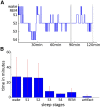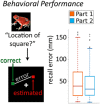Memory consolidation by replay of stimulus-specific neural activity
- PMID: 24305832
- PMCID: PMC6618788
- DOI: 10.1523/JNEUROSCI.0414-13.2013
Memory consolidation by replay of stimulus-specific neural activity
Abstract
Memory consolidation transforms initially labile memory traces into more stable representations. One putative mechanism for consolidation is the reactivation of memory traces after their initial encoding during subsequent sleep or waking state. However, it is still unknown whether consolidation of individual memory contents relies on reactivation of stimulus-specific neural representations in humans. Investigating stimulus-specific representations in humans is particularly difficult, but potentially feasible using multivariate pattern classification analysis (MVPA). Here, we show in healthy human participants that stimulus-specific activation patterns can indeed be identified with MVPA, that these patterns reoccur spontaneously during postlearning resting periods and sleep, and that the frequency of reactivation predicts subsequent memory for individual items. We conducted a paired-associate learning task with items and spatial positions and extracted stimulus-specific activity patterns by MVPA in a simultaneous electroencephalography and functional magnetic resonance imaging (fMRI) study. As a first step, we investigated the amount of fMRI volumes during rest that resembled either one of the items shown before or one of the items shown as a control after the resting period. Reactivations during both awake resting state and sleep predicted subsequent memory. These data are first evidence that spontaneous reactivation of stimulus-specific activity patterns during resting state can be investigated using MVPA. They show that reactivation occurs in humans and is behaviorally relevant for stabilizing memory traces against interference. They move beyond previous studies because replay was investigated on the level of individual stimuli and because reactivations were not evoked by sensory cues but occurred spontaneously.
Figures






References
-
- Buzsáki G. Rhythms of the brain. Oxford, New York: Oxford UP; 2006.
Publication types
MeSH terms
LinkOut - more resources
Full Text Sources
Other Literature Sources
Medical
Research Materials
